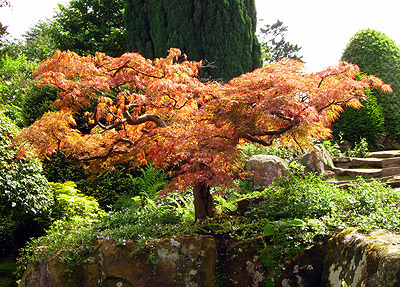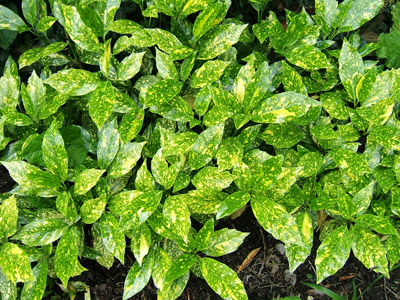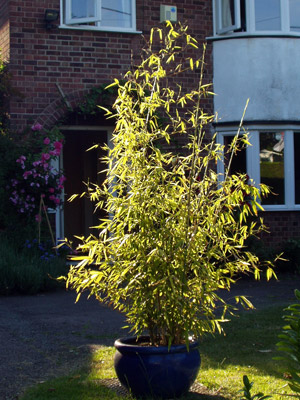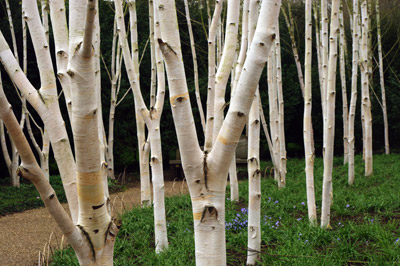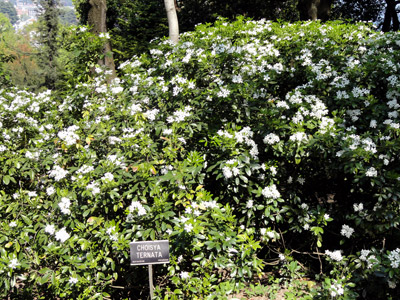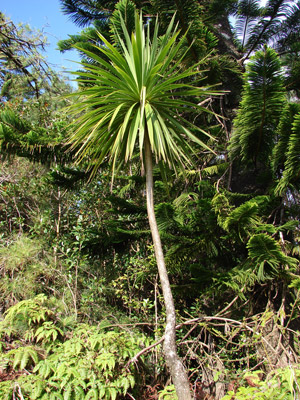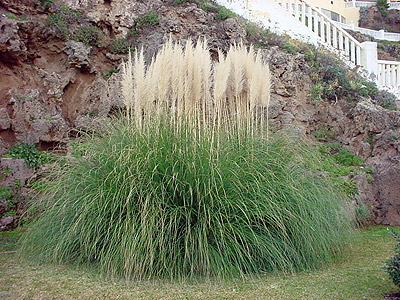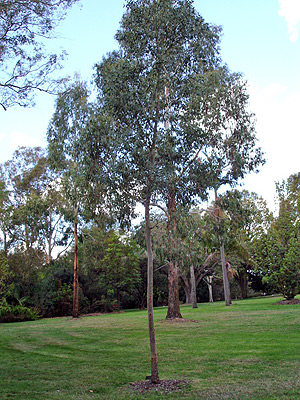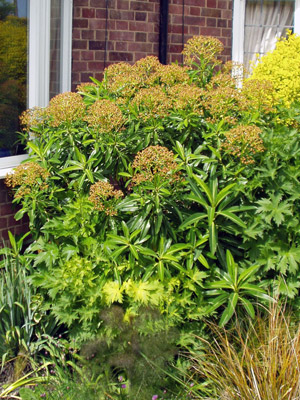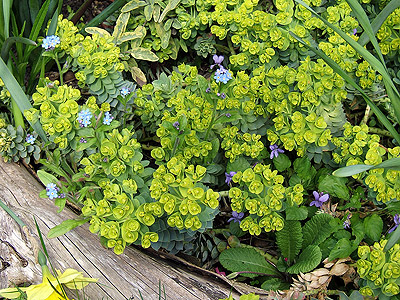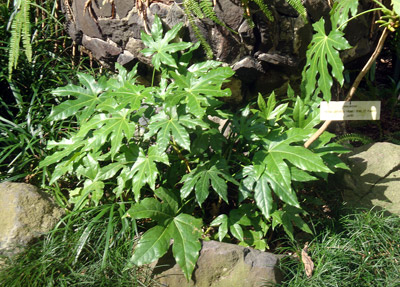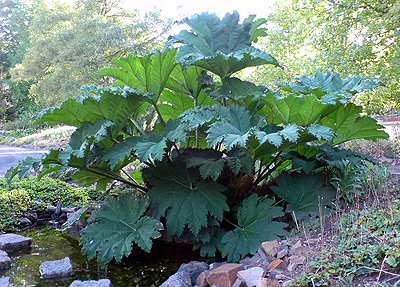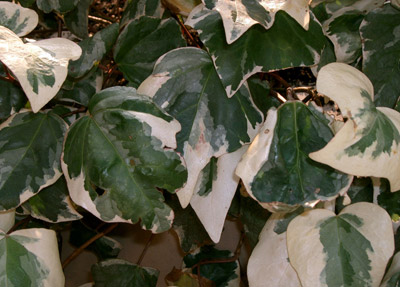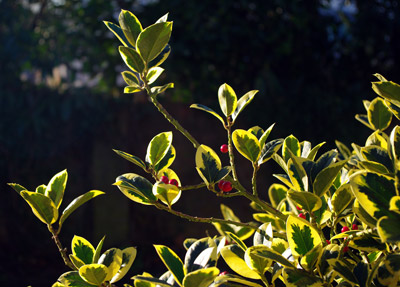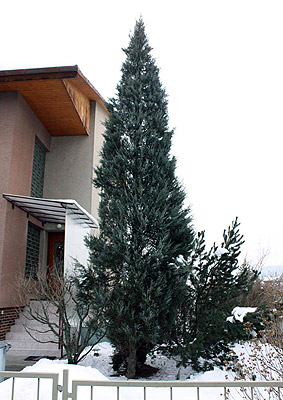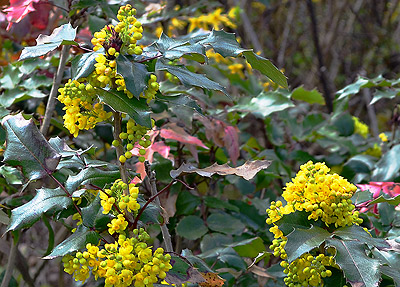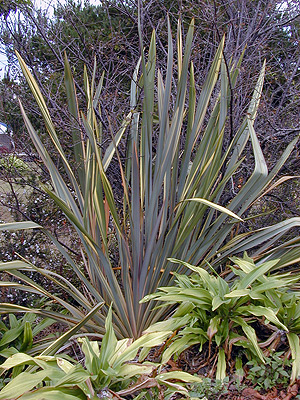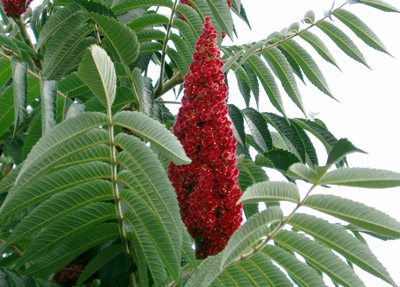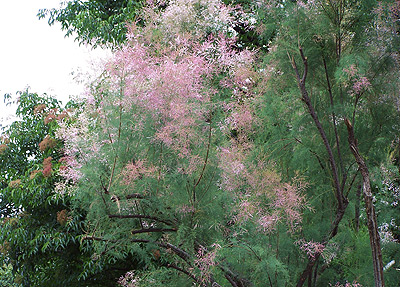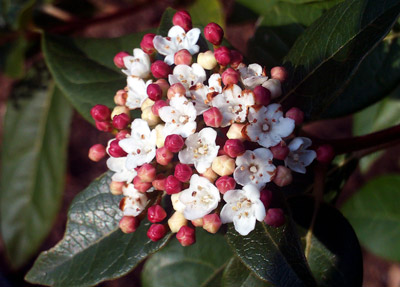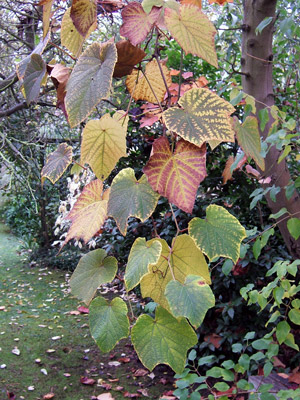Architectural Plants
Architectural plants are elegant permanent residents of your garden that give it its backbone. If your garden is a room, then the architectural plants are the furniture while other shorter-lived and smaller plants are the pictures and ornaments. Whether a plant is "architectural" is pretty much a matter of opinion and so this is an arbitrary group.
There are some qualifying traits that a plant should have to be regarded as architectural, in particular it should have a strong and distinctive shape, both of the leaves and of the overall growth pattern. It is also helpful if the plant is either evergreen, or has a distinctive winter presence, bark colouration, shape of branches etc. so that your garden doesn't become dull in the winter. By definition architectural plants tend to be fairly large.
Arguably all trees should fit into this category and in the summer they probably do, what is needed is year-round interest and not so much of a "blobby" shape.
The plants here are recommended as they are reliable in most soils in most regions and fairly widely available.
Abies koreana
- Korean Fir
Tree
Conical conifer with darkish green leaves. Produces purple-blue cones from an early age which are very decorative. A well shaped and proportioned tree, to 30ft tall and 20ft wide.
Acer palmatum,
Japanese Maples- assorted
Tree
The archetypal Japanese tree, usually bought as a small specimen 1-2ft tall. Not tolerant to being exposed to cold, wind or full sun and best grown initially at least in a container so you can move them about to find the best position. They don't like chalky soils preferring it on the acid-side.
Numerous cultivars available, one of the commonest (and cheapest) being "atropurpureum" which needs positioning carefully as it can appear rather dark and dense and can burn easily. The "dissectum" cultivars are very beautiful with finely cut leaves. "Aureum" has plainer shaped leaves but a lovely bright yellow colour. "Sango-kaku" (senkaki) has bright coral-red winter shoots with yellow autumn leaves.
Aucuba japonica
- Spotted or Cuban laurel
Shrub
Evergreen shrub, with glossy leaves to 8" long spotted yellow. Plants are either male or female, females have bright red berries in autumn. Tolerant of quite deep shade and indeed requires some shade to be really happy. Will grow in difficult situations and tolerant of dry soil. To about 10ft high and wide but easily controlled and fairly slow growing. Frequently sold as three or four rooted cuttings in a pot, separate them and you instantly have more plants!
Bamboos
Shrub /
Perennial
A large and varied group of graceful grasses which contrary to popular belief are usually hardy and not invasive. In the main they are fairly slow growing. The length of the stems is connected to the extent of the root system. So if your young plant doesn't produce 8ft high canes immediately, give it a chance to establish.
Bamboos are evergreens and not affected by any major pest or disease in this country (there's little chance that panda's will start eating the emerging shoots). They are not always able to cope with exposed windy conditions which often makes them look a bit tatty and threadbare. they all prefer dampish conditions and won't really withstand being baked by the sun with little moisture available.
Arundinaria nitida - Fountain Bamboo, is a handsome one with dark purple-green canes and dark green leaves, to 15ft high by 5ft wide. Arundinaria murieliae - Umbrella Bamboo is similar but more, well, umbrella-shaped. Yellow-green canes at first turning yellow with age. Phyllostachys nigra - Black bamboo is particularly striking with canes that start green but then turn black in the second or third year 10-15ft high by 6ft wide.
Bamboos, particularly large specimens are not cheap but are fairly easily propagated by division when grown in containers, keep moving them on to bigger and bigger pots.
Betula spp.
- Silver birches
Tree
The birches are admirable trees for small gardens, some types can grow tall (eventually to 50ft or more), but they tend not to spread very far and have an open canopy that gives a dappled shade, a lovely effect. They need an open sunny situation.
The native silver birch Betula pendula is a popular choice, but the bark is rather rough and splits with dark patches forming with age, go for named cultivars such as "Dalicarlica" "Laciniata"or "tristis" if you can find them, plant cultivars come and go however, there will always be new ones. I prefer the Himalayan birch, Betula utilis "jacquemontii", usually sold as Betula jacquemontii (sometimes called the West Himalayan birch) or the paper birch, Betula papyrifera. Both have a smoother, brighter bark than the native species and are fairly easy to find.
If you have more space, birches can be planted as a triangular group of 3 about 3 feet apart. You tend to get a similar canopy as if a single tree was on its own, but 3 times the trunks and bark which is the main feature.
Choisya ternata
- Mexican Orange Blossom
Shrub
Glossy evergreen shrubs that comes in two main types grown either for wonderfully fragrant white flowers in summer (and often again in autumn) with green leaves, or for vibrant yellow leaves in the variety "Sundance" which unfortunately rarely flowers. "Aztec Pearl" is a flowering green variety with leaves that are more delicately cut.
Often described as having "fragrant foliage", I think beauty is definitely in the nose of the beholder on this one. Probably not so bad in small doses, and the smell is only released when the leaves are rubbed.
The flower scent however is exceptional. To about 6-8ft tall and wide. Best in sun.
Cordyline australis
- Cabbage
palm
Shrub
Larger outdoor versions of the dragon-trees and ti-trees often grown as houseplants. Evergreen woody tree-like shrub or perennial. Can grow to 10-12ft or more in parts of the country that have reliably mild winters.
These are not fully hardy, but with our increasingly frequent and increasingly mild winters, they survive year round more and more. Don't push it too far, plant them in sheltered areas away from strong winds and with the protection of a wall if possible. They can be helped over the winter by tying the leaves together with some soft string in the late autumn to protect the tender heart of the plant from frosts.
Cortaderia selloana
- Pampas grass
Perennial
It's had a bit of a bad press has poor old pampas grass with its connotations of 70's housing estates. Like some other plants though, it's earned its reputation unfairly, largely as a result of being planted inappropriately. It is a big plant 6ft tall by about the same wide with flower panicles to 10ft, so plant it slap bang in the middle of a small lawn and it will look completely overwhelming. Maybe people thought "oh its only a grass, it can't be that big".
Best planted at the margins of a garden or at the back of a mixed border unless you have great expanses of lawn. If you can, plant it so that the sun sets behind it when viewed from your house or usual garden viewing place and you could well come to love it. It's very resilient and an easy plant to grow, try it in a difficult area where its natural vigour may well allow it to thrive while the difficult conditions will keep it smaller than normal size (but with less flower panicles).
Eucalyptus
gunnii - Cider Gum
Shrub / Tree
A tree if left to its own devices that will go to 50ft + if it's happy. However, don't be too alarmed. What you need to do is treat it as a coppice stool. Let the plant get established for one or two years and then in Feb / March you cut it down to about 4-6" above ground level. This encourages it to throw out new shoots from just below the cut point. The plant will then provide you with lots of very attractive glaucous blue/green juvenile foliage that can grow up to 6ft from ground level in a season. It's also reputed to keep midges and mosquitoes at bay, so plant it near the patio.
A very beautiful foliage plant, excellent against rather dull fences and as a contrast to other leaf colours and shapes. Tends to be a bit fussy about position. Likes to be well drained so incorporate lots of pea shingle when planting it in heavier soils and only plant in full sunshine, otherwise 6ft growth a year becomes 6mm.
Euphorbia
mellifera - Honey
Spurge
Shrub / Perennial
The evergreen Euphorbias sound as dull as ditch water from a simple description of their insignificant small flowers surrounded by greenish or yellow bracts. They manage however to be one of the most striking groups of garden plants and one of my favourites (hence three entries!). Somehow with a restricted palette of shades of green and yellow, they manage to "glow" in the garden, a definite example to the more gaudy garden residents that "less is more".
E. mellifera is one of the larger members of the
group and is well placed at the back of the border.
It has vibrant apple-green leaves and the flowers while
not being particularly striking, have a probably unique
scent of honey. An excellent addition to any garden.
To 8ft tall and wide. Best in sun tolerates some shade,
not fond of exposure so molly coddle it a bit if you
can.
Buy
Euphorbia mellifera
Euphorbia characias
Shrub
Bluish green leaves to about 4ft tall. Particularly
bright green-yellow "flower" heads in spring.
Well known and deservedly so. Reputed to emit a coffee
scent.
Buy
Euphorbia characias
Euphorbia myrsinites
Perennial
Completely different habit to E. mellifera above. A prostrate creeping plant with blue-green leaves, yellow "flowers" in spring. 4" tall and spreads to about 18", a succulent so needs reasonable drainage, goes well with spiky plants or against gravel / rocks etc.
Fatsia japonica
- castor oil plant
Shrub
A large plant with large bright glossy leaves up to 36" long in mature specimens. Chiefly a foliage plant, but also produces long lasting white flowers as a bonus which are followed by masses of black berries. Fits into many different styles of garden, but best in formal or jungly / tropical types. Grows in sun and also in quite deep shade. To 12ft by 12ft but not for ages.
Gunnera manicata
- Giant rhubarb
Perennial
The common name sums it up very well, although this one is from the South American jungles and inedible. The leaves are enormous, up to 6ft across borne on prickly stalks to 8ft long. It is really a bog plant and needs moist conditions, if you think you might be able to accommodate its requirements and size, then little else will get the same WOW! effect, I love them. Also notable in that it dies back totally in winter (protect the base of the crown with a thick manure mulch) and so all of this fabulous growth happens from ground level each season. To 8ft tall and 10-12ft across.
Hedera canariensis
- Canary island ivy - variety, "Gloire de Marengo"
Climber
Large shiny variegated leaves with a jungly feel. Not as hardy as most Ivies you see (which are often as tough as old boots), so benefits from some shelter. Grow as a climber up a wall or use as ground cover, pretty vigorous in both situations. To 12ft.
Ilex spp.
- Holly
Shrub / Tree
Useful for their evergreen foliage and winter colour provided by berries and / or variegated leaves. Slow growing and usually only available as smaller specimens as they don't take too kindly to being moved. Will tolerate shade, especially the darker-leaved forms, variegated types require sun to bring colours out to the optimum. Hollies are usually either male or female and only the females have the berries, but they need a male to achieve this! The naming of varieties doesn't help the situation however - see below:
Ilex aquifolium "Argentea marginata"
- variegated, female.
I. aquifolium "Golden
King" variegated female, red berries.
I. aquifolium " J.C. van tol"
- self-fertile female, abundant red berries, dark green
smooth margined leaves.
One of my favourites
Ilex aquifolium "ferox argentea",
hedgehog holly - variegated, male with spikes all
over the surface of the leaf, a bit more fussy about
soil than the others.
Juniperus scopulorum
Tree
A more reliable alternative to the Italian cypress in the British climate and a very lovely tree in its own right. Narrowly upright with a blue-grey tinge to the foliage best brought out when planted in full sun.
Use a pair either side of a path or entrance, or as a punctuation mark in planting schemes.
Mahonia aquifolium
- Oregon grape
Shrub
Evergreen shrubs with shiny dark green holly-like leaves and large sprays of highly scented yellow flowers in the winter months. Make sure you plant it near a path or doorway otherwise you may never be tempted to venture out and appreciate the scent. Other Mahonia species are also avialbel, M. aquifolium is the toughest and will withstand quite deep shade ("Apollo" recommended variety). Others though are more delicate and less shade tolerant such as, M. x media "Charity" and M. bealei, plant one of these if conditions allow. Flowers are followed by bunches of fruit that look very like blueberries.
Phormium tenax
- New Zealand Flax
Perennial
Great evergreen fans of sword-shaped leaves up to 10ft long in green, purple or many variegated varieties. These plants will grow large! up to 10-12ft across. Flower spikes up to 12ft tall in the "interesting and striking" rather than "pretty" category.
On a different note, the Maoris of New Zealand were using these to weave all kinds of things before anyone got the idea of planting them in the garden and showing off about it. "I always liked them actually, they just became trendy afterwards"
The ordinary green one is the best for my money, and Phormiums actually prefer clay!
Rhus typhina "laciniata"
- Stags Horn Sumarch
Shrub
A striking shrub or small tree that earns its common name due to the shape of the branches in the winter. Handsome pinnate leaves up to 18" long that give very good autumn colours. Tends to sucker quite a lot, but a small price to pay for such a handsome plant, it also means that you get some extra plants for free to give to friends. To about 15ft tall and wide.
Tamarix ramosissima
- Tamarisk
Shrub
A graceful shrub to small tree, wispy frothy pink flowers produced in summer amongst wispy frothy mid green foliage. Will withstand a surprising degree of wetness at the roots, but not permanently soggy. Height and spread to 15ft.
Viburnum tinus
Shrub
Bushy dense evergreen shrub eventually to about 10ft tall and wide. Fragrant white flowers borne over a long period through winter and spring, followed by blue/black berries. Tolerates a fair amount of shade and can be hard pruned.
Vitis coignetiae
- Crimson glory vine
Climber
One of my favourite climbers this one, large bright green heavily textured leaves up to 12" across whose autumn colours earn it its common name as they change colour culminating in bright crimson.
A vigorous and large plant that will grow to 50ft if given space in a mature tree, alternatively grow it up and over a pergola to give summer shade and autumn fireworks.
Picture credits: Abies koreana - Lestat Jan Mehlich - Creative Commons 3.0 Attribution Share and Share Alike Unported license | Acer palmatum - public domain | Choisya ternata - public domain | Cordyline - Forest and Kim Starr - Creative Commons 3.0 Attribution Unported license | Pampas Grass - Hans Olav Lien - Creative Commons 3.0 Attribution Unported license | Eucalyptus gunnii - public domain | Fatsia - Lijealso - Creative Commons 3.0 Attribution Unported license | Hedera Gloire de Marengo - KENPEI - Creative Commons 3.0 Attribution Share and Share Alike Unported license | Gunnera manicata - public domain | Juniper Skyrocket and Mahonia - Malchen 53 - Creative Commons 3.0 Attribution Share and Share Alike Unported license | Phormium - Forest and Kim Starr - Creative Commons 3.0 Attribution Alike Unported license | Rhus typhina - Daniel Fuchs - Creative Commons 2.5 Attribution Share and Share Alike Generic license | Tamarix - Jerzy Opiola - Creative Commons 3.0 Attribution Share and Share Alike Unported license | Viburnum tinus - public domain | Aucuba japonica, Bamboo, Betula, Euphorbia, Holly, Vitis - copyright Paul Ward
Copyright 2000 - present. All Rights Reserved | Privacy Policy Statement


